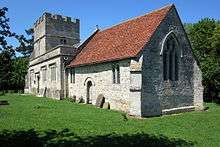St Bartholomew's Church, Furtho
| St Bartholomew's Church, Furtho | |
|---|---|
 St Bartholomew's Church, Furtho, from the southeast | |
 St Bartholomew's Church, Furtho Location in Northamptonshire | |
| Coordinates: 52°04′51″N 0°52′22″W / 52.0808°N 0.8728°W | |
| OS grid reference | SP 773 430 |
| Location | Furtho, Northamptonshire |
| Country | England |
| Denomination | Anglican |
| Website | Churches Conservation Trust |
| History | |
| Dedication | Saint Bartholomew |
| Architecture | |
| Functional status | Redundant |
| Heritage designation | Grade II* |
| Designated | 17 June 1960 |
| Architectural type | Church |
| Style | Gothic |
| Groundbreaking | 12th century |
| Completed | 1620 |
| Closed | 1920 |
| Specifications | |
| Materials |
Limestone, Slate and tile roofs |
St Bartholomew's Church is a redundant Anglican church in the former village of Furtho, Northamptonshire, England. It is recorded in the National Heritage List for England as a designated Grade II* listed building,[1] and is under the care of the Churches Conservation Trust.[2] A former medieval village, it became deserted when the road from London to Northampton was diverted away from it. All that remains in the vicinity of the church is a farm and a dovecote.[2]
History
The church dates from the 12th century, with additions and alterations in the 14th century. It was substantially rebuilt in about 1620 and was restored in 1870.[1] It ceased to be a parish church in 1920.[2] During the Second World War the church was used for storage of the archives of the Northampton Record Society, and during that time all the windows were destroyed by a bomb.[3] The church was declared redundant on 16 May 1989, and was vested in the Churches Conservation Trust on 7 June 1990.[4]
Architecture
Exterior
St Bartholomew's is constructed in limestone. The roof of the nave is in slate, and the roofs of the chancel and tower are tiled. Its plan consists of a three-bay nave, a two-bay chancel and a west tower. The tower is built partly within the west end of the nave. It is in two stages, and has diagonal buttresses and a pyramidal roof. In the lower stage is a three-light west window, and the upper stage has three-light bell openings. The parapet is battlemented. The nave contains three-light, arched, mullioned windows. There are Tudor arched doorways in both the north and south walls. On the east gable is a finial. The east window has three lights. In the south wall of the chancel is a pair of two-light windows with Decorated tracery, and a round-arched priest's door.[1]
Interior
In the chancel is a trefoil-headed piscina and a tomb recess. On each side of the east window is a bracket for an image.[1] Also in the chancel is a marble memorial to Anthony Furtho, who died in 1558, and his two wives, and a monument to Edmund Arnold dated 1676.[3] The octagonal font is small and dates from the 17th century.[1]
See also
References
- 1 2 3 4 5 Historic England, "Church of St Bartholomew, Potterspury (1191073)", National Heritage List for England, retrieved 15 October 2013
- 1 2 3 St Bartholemew's Church, Furtho, Northamptonshire, Churches Conservation Trust, retrieved 29 March 2011
- 1 2 Furtho, St Bartholomew's Church, Britain Express, retrieved 3 October 2010
- ↑ Diocese of Peterborough: All Schemes (PDF), Church Commissioners/Statistics, Church of England, 2011, p. 2, retrieved 7 April 2011